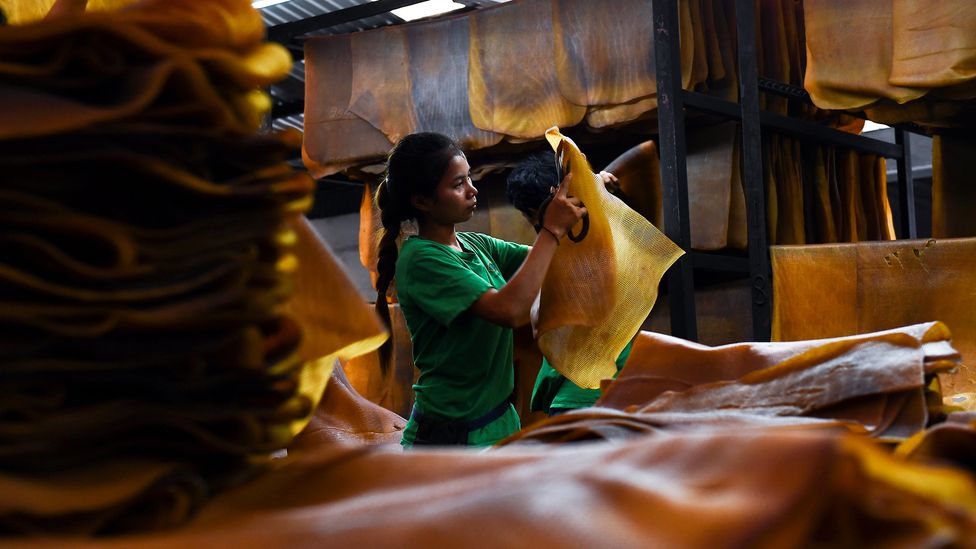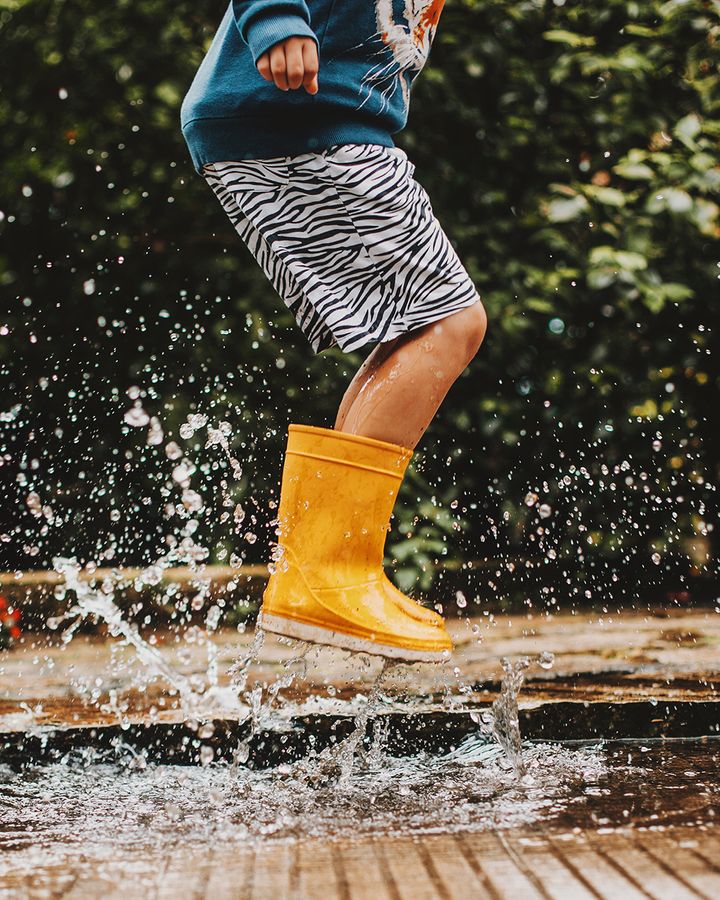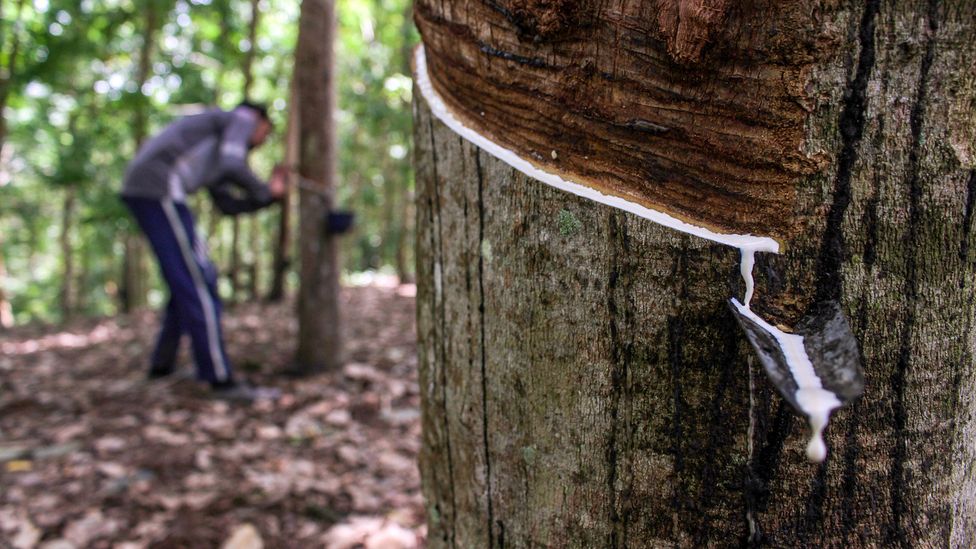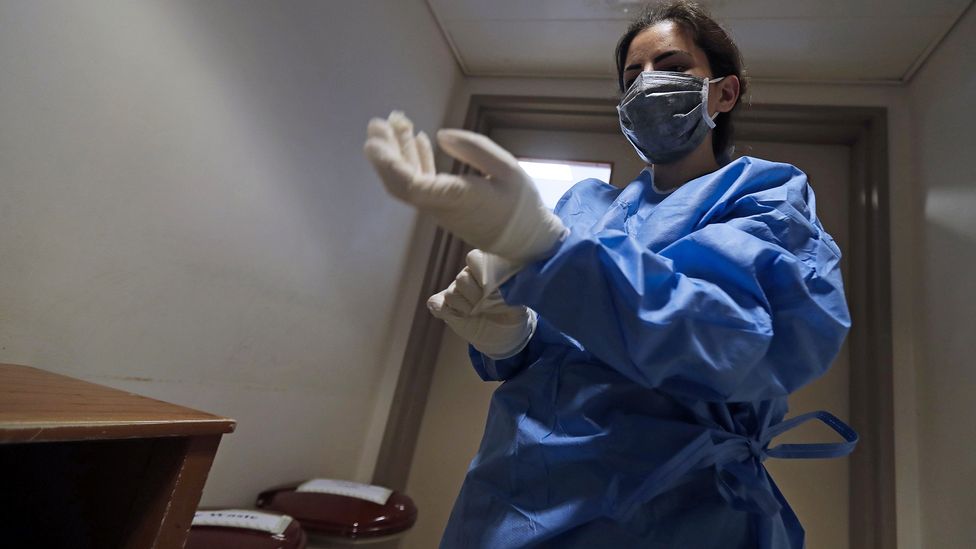Natural rubber is a uniquely tough, flexible and highly waterproof material. It puts tyres on our vehicles, soles on our shoes, it makes seals for engines and refrigerators, insulates wires and other electrical components. It is used in condoms and clothing, sports balls and the humble elastic bands. Over the past year it has played a pivotal role in the pandemic in personal protective equipment worn by doctors and nurses around the world.
In fact, rubber is deemed to be a commodity of such global importance that it is included on the EU's list of critical raw materials.
Unfortunately, there are signs the world might be running out of natural rubber. Disease, climate change and plunging global prices have put the world's rubber supplies into jeopardy. It has led scientists to search for a solution before it's too late.
You might also like to read:
- How we can go palm oil free
- Why the world is running out of sand
- The dead zones holding great riches
But how has such an important commodity fallen into such peril in the first place?
The global supply of natural rubber – around 20 million tonnes per year – is produced almost entirely by fragmented smallholders working tiny plots of land in tropical forests. Millions of these workers tend to plantations in Thailand, Indonesia, China and West Africa, carefully stripping bark from the trees to extract a milky white sap which is shaped into sheets and dried in the sun. Between them, these farmers provide 85% of the world's natural rubber supply.

Most of the world's natural rubber comes from Southeast Asia, but low prices are causing some farmers to give up the crop (Credit: Jonathan Klein/Getty Images)
But this fragile supply is under threat. A native of the Brazilian rainforest, the rubber tree Hevea brasiliensis is no longer grown commercially in the country due to the prevalence of South American leaf blight, a catastrophic pathogen which killed off the country's rubber industry in the 1930s. Strict quarantine controls have kept the disease contained to the South America for now, but arrival in Asia is thought to be almost inevitable.
In the meantime, farmers elsewhere in the world still face local pathogens such as white root disease and other leaf blights that have made the leap from neighbouring oil palm plantations. Climate change is also exerting its toll – Thailand's rubber production has been hit by droughts and flooding in recent years, with the latter also further spreading disease-causing microbes across growing regions.
A growing demand for rubber and short supply should be good news for the farmers, as it would make rubber more profitable to grow. Unfortunately, that's not the case. The price of rubber is set by the distant Shanghai Futures Exchange, where brokers speculate on value of this material alongside gold, aluminium, and fuel. "The pricing has nothing do with the cost of production," says Robert Meyer, co-founder of rubber buyer Halcyon Agri. Because of this arrangement, the price of rubber per tonne can vary three-fold from one month to the next, and in recent years has been held at very low values.
This situation further jeopardises the supply of rubber. "The mathematics smallholders make is that income equals price times volume," explains Meyer. Low prices force farmers to over-tap their trees to obtain more rubber, weakening the plants and making them more susceptible to disease. The low prices have also discouraged planting of new trees to replace those at the end of their commercial lifespan, and many farmers have abandoned plantations entirely.
Eleanor Warren-Thomas is a research fellow at University of Wales Bangor, UK, who has studied the dynamics of rubber plantations. "Oil palm and natural rubber make the same money per unit of land, but the labour input is higher for rubber," she says. "Because the rubber price is falling, farmers are switching from producing rubber to selling the timber for near term profit, and growing oil palm instead."
These factors combined means that the world is now at a point where the supply of natural rubber is not keeping up with demand. In late 2019, the International Tripartite Rubber Council warned the global supply would fall short by one million tonnes (900,000 tons) in 2020, around 7% of production. Then the pandemic hit.
Demand reduced immediately, and driven miles – the key measure for ultimate demand for rubber – dropped as countries went into lockdown. But rubber soon bounced back. "Demand outpaced even the most bullish predictions," says Meyer. As they came out of lockdown, Chinese citizens bought huge numbers of new cars, thanks to fears around the safety of public transport. Similar patterns are expected globally. "Demand has since eclipsed supply," says Meyer. "Now there is an acute shortage (of rubber) in destinations, and inventory held by tyre makers is very low."
Although synthetic rubber can be produced from petrochemicals, natural rubber has unique properties which even these synthetics can't match: natural latex gloves are more resistant to tear than nitrile ones, while aircraft tyres use natural rubber for its high elasticity and resistance to heat, which can build up from friction during landing.

Natural rubber is an invaluable resource due to is wide range of properties – from its elasticity and insulating capabilities to waterproofing (Credit: Carol Yepes/Getty Images)
Part of the problem is that migrant workers responsible for collecting the rubber still can't cross borders, so trees are going untapped. And the factories which process rubber into usable products stopped for several months during the spring last year. But the bigger issue is that shortages are the result of deep structural problems that aren't easy to fix. That has spurred the hunt for emergency measures that can save us from a rubber crisis.
The obvious answer might be to plant more rubber trees. And once the rubber shortage begins to bite and prices climb, farmers will be incentivised to clear tropical rainforest to plant more rubber. Although palm oil plantations have received far more attention, rubber plantations can be just as bad for biodiversity loss, according to Warren-Thomas.
A spike in prices driven by growing demand in China in 2011 led to massive deforestation in Southeast Asia as governments released forested land for development to cash in on the trend. In Cambodia alone, rubber plantations were responsible for a quarter of all deforestation. Yet it will be a long time before these trees are ready for tapping – the growing process takes seven years.
We could try to squeeze more rubber out of existing plantations. "In Indonesia, there is a big opportunity to increase yield," says Katrina Cornish, professor of bioemergent materials at Ohio State University in the US. "They are growing the same clones as Thailand and Malaysia but yields are much lower, so crop management could be better. The immediate pain could be alleviated with existing trees." One option is to apply ethephon to trees, a chemical which stimulates the tree to produce more latex sap. But too much of this agent can kill the trees, making some farmers reluctant to use it.
Another option is to forgo Hevea brasiliensis altogether. "The increase in production needs to be filled by alternatives, not Hevea," says Cornish. Ohio State University is part of the programme of excellence in natural rubber alternatives (PENRA), an industry partnership dedicated to averting the looming crisis. There, researchers are exploring plants which might step in to replace the rubber tree.
One of the plants under investigation is Taraxacum kok-saghyz, a small weedy plant cultivated by the Russians when the supply of Asian rubber was threatened during World War Two (the USA also experimented with it as an emergency rubber crop). "Just don't call it the Russian dandelion," warns Cornish. "It's from Kazakhstan, they get quite annoyed by that."
The Kazakh dandelion produces about a tenth as much rubber per acre as rubber trees and is extracted by crushing and pressing its roots. But it is ready to harvest in three months, and produces large amounts of seeds, making it easy to replant and scale up production. And while it's chemically similar to natural rubber, it doesn't contain the proteins which cause latex allergies.
Last year, the German research institute Fraunhofer ISC unveiled a tyre named Biskya, from the German abbreviation for Biomimetic Synthetic Rubber. Made from dandelion rubber, the company claims it has superior resistance to wear and tear than typical rubber. At OSU Cornish and her colleagues are developing varieties and cultivation techniques – including hydroponics and vertical farms – to help make dandelion rubber a commercial reality. Under their system, the sap filled dandelion roots can be harvested five times a year.
Also attracting interest is guayule (pronounced wai-oolie), a woody shrub that grows in the deserts that border the US and Mexico. Starved of rubber during World War Two, the USA briefly pressed guayule into production.

Natural rubber is obtained by carefully stripping bark from rubber trees and collecting the latex sap (Credit: Maskur Has/Getty Images)
Under the Emergency Rubber Project, a small army of scientists and labourers toiled to cultivate 13,000 hectares (50 sq miles) of guayule, which was soon producing around 400 tonnes (393 tons) of rubber each month. The shrub takes two years to produce its first crop, but can be pollarded (pruning the upper branches) and moved to an annual harvest after that. With the end of the war, however, the programme was abandoned as cheap Asian rubber came back onto the market.
Today, only two companies produce rubber commercially from guayule, including Yulex, which offers a part-guayule wetsuit through clothing company Patagonia. Tyre manufacturer Bridgestone maintains a 114 hectare (0.5 sq miles) experimental plot of guayule in Arizona, which produced its first tyres in 2015. It was assisted by Italian oil giant Eni, which maintains a guayule test plot in Sicily.
The urgency to scale up these tentative efforts will only get more acute. Global demand for natural rubber will keep increasing, especially as developing nations grow wealthier. "Cars are the biggest share of the rubber market, and if every if every African family ends up with two cars, that's a heck of a lot of rubber," says Cornish .
There are signs of change: many of the large buyers of rubber including Bridgestone, Continental and Goodyear have signed up to the Global Platform for Sustainable Natural Rubber, which forbids buying rubber grown on recently deforested land. Meyer is now campaigning to introduce a fixed minimum price for rubber. Like Fair Trade schemes for coffee and cocoa, this would guarantee the livelihoods of smallholders in developing nations, and help to ensure the supply of rubber was more robust.

Rubber finds many applications in medical equipment and has been particularly important in the pandemic in PPE (Credit: Joseph Eid/Getty Images)
"I'm not doing this to get rich or stay rich for one quarter or two, I need to look at the long term," says Meyer. "What I'm looking for is a sustainable supply, that doesn't run contrary to human conscience."
Warren-Thomas adds: "We must support smallholder farmers to do the best they can, make them resilient to price shocks – improving productivity systems and allowing them to have secondary crops. Ultimately further deforestation for these cash crops is bad news for climate, bad news for biodiversity, bad news for people, and needs to be thought about carefully indeed."
The arrival of South American leaf blight in Asia would make these concerns a moot point. "Just think of emerald ash borer, elm disease, pine beetle – you can lose an entire species, billions of trees, and you can't just replace 40 million tonnes (39 million tons) of rubber when the whole lot dies in a year," says Cornish.
Cornish posits that if at least 10% of the rubber used worldwide came from alternative sources, they could be scaled up quickly in the event of just such an emergency. Arizona alone has over three million hectares (11,600 sq miles) of desert land suitable for growing guayule. Cornish says the rubber crisis is a once-in-a-generation opportunity to attract investment into these alternatives.
"We have enough dandelion seed to put in 40 hectares (0.15 sq miles) of vertical farm, and 3,000 hectares (11.6 sq miles) of guayule, but we need the funds to do it," says Cornish. "We need some of those billionaires to get involved. I am determined to get this established before I die. We've got to get it to work. The consequences to the developed world if the crop fails are unthinkable."
--
Join one million Future fans by liking us on Facebook, or follow us on Twitter or Instagram.
If you liked this story, sign up for the weekly bbc.com features newsletter, called "The Essential List". A handpicked selection of stories from BBC Future, Culture, Worklife, and Travel, delivered to your inbox every Friday.
"need" - Google News
March 09, 2021 at 08:06AM
https://ift.tt/3t6mktV
The wonder material we all need but is running out - BBC News
"need" - Google News
https://ift.tt/3c23wne
https://ift.tt/2YsHiXz
Bagikan Berita Ini















0 Response to "The wonder material we all need but is running out - BBC News"
Post a Comment